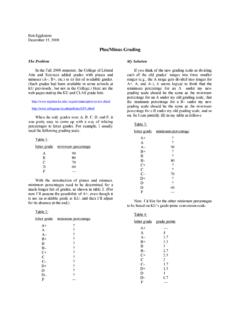Transcription of Plus/Minus Grading - bulletin.uga.edu
1 Plus/Minus Grading Some members of the University faculty have asked for guidance with regard to Grading scales for the new Plus/Minus Grading system. Although all faculty must use a Plus/Minus Grading system, the University leaves to the discretion of each individual faculty member how grades will be assigned in each class. The following grade weights for the Plus/Minus system were approved by the Board of Regents: A A- B+ B B- C+ C C- D F Members of the Plus/Minus Grading Subcommittee of the University Curriculum Committee provided a small sample of possible Plus/Minus Grading schemes (attached).
2 Again, we do not recommend that any of these schemes be used; they are provided as a non-representative sample of possible schemes. Given the change to Plus/Minus Grading , we encourage the faculty and departments to have a conversation about Grading , particularly with respect to Grading in multiple sections of the same course. Discussions on grade inflation might also be appropriate with the change in Grading scales. SAMPLE Grading SCALES Sample 1 A 94-100 A- 90-93 B+ 87-89 B 84-86 B- 80-83 C+ 77-79 C 74-76 C- 70-73 D 65-69 F 64 and below Sample 2 A >93 A- 90-93 B+
3 87-90 B 83-87 B- 80-83 C+ 77-80 C 70-77 C- 65-70 D 60-65 F 60 and below Sample 3 A A- - B+ - B B- C+ - C C- D F and below Sample 4 A >93 A- 90-93 B+ 87-90 B 83-87 B- 80-83 C+ 77-80 C 73-77 C- 70-73 D 60-70 Sample 5 A 90-100 A- 87-89
4 B+ 84-86 B 80-83 B- 77-79 C+ 74-76 C 70-73 C- 67-69 D 60-66 F 59 and below Sample 6 A 90-100 A- B+ B B- C+ C C- D F and below Sample 7 A A- B+ B B- C+ C C- D F and below F <60 Subjective Approaches.
5 Particularly in smaller classes, many instructors use a more qualitative, subjective Grading scale by looking at the individual students' achievements and finding natural breaks in the grade distributions. Instructors using these methods might consider using the Plus/Minus grades to help further distinguish within these natural breaks. As suggested in the numerical schemes presented, it might also be reasonable to use plus and minus grades to adjust slightly the distinctions between the letter grades. One example of this follows: Grades are assigned using the following rules: 1. 90% receives at least an A 80% receives at least a B 70% receives at least a C 60% receives at least a D < 60% receives at least an F 2.
6 With the Plus/Minus Grading system the following grades are also available for assignment: A-, B+, B-, C+, and C-. These grades are used to differentiate performance, if warranted. For example, a student earning an 82% is guaranteed at least a B. However, the student may receive a B+, A-, or A depending on my assessment of the rigor of the evaluation exercises (tests, quizzes, papers, etc.) and whether the student has a performance which is clearly superior to students in the same range receiving a B grade. 3. The rank ordering of grades will not deviate from the rank ordering of student performance. For example, a student earning a 75% will not receive a higher letter grade than a student earning 76%.
7 Another approach: Final course grade is determined based on the final distribution of all grades in the class, not on any specific grade cut-off. Final grades are assigned using the following guidelines: A: achievement that is outstanding and well above the level necessary to meet course requirements; B: achievement that is above the level necessary to meet course requirements; C: achievement that meets the basic course requirements; D: achievement that is worthy of credit even though it does not fully meet the basic course requirements; F: achievement that fails to satisfy the basic course requirements. In order to calculate final grades, the final grades are first plotted from lowest to highest to look for discontinuities in the grade distribution in order to establish broad grade categories (A,B,C,D,F).
8 This has the advantage of not giving students with very similar numerical grades different letter grades. Within these broad grade categories, we look for further discontinuities in the final grade distribution to determine Plus/Minus grades. In addition to these discontinuities, we look at the specific performance on each assignment for each student around the breakpoint. This individual consideration also helps determine where we will place the cut-off between these finer grade distinctions.




